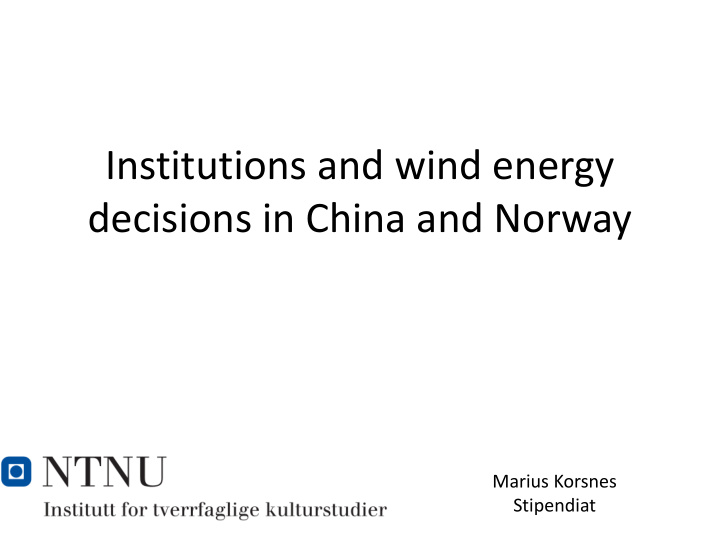



Institutions and wind energy decisions in China and Norway Marius Korsnes Stipendiat
Installed capacity of wind power in China, 2000 - 2011 70 60 50 China 40 USA GW Germany 30 Spain India 20 10 - 2000 2001 2002 2003 2004 2005 2006 2007 2008 2009 2010 2011
The 15 biggest wind turbine manufacturers globally, and market share in 2010
Wind in China and Norway, 2011 China Norway Installed capacity 63,000 MW 525 MW Annual generation 70 TWh 1,3 TWh Resource potential 2,580 GW (ca. 2860 TWh) 1243 TWh (ca. 500 GW) % of total domestic 1,5 % 1 % electricity - Large difference in capacity factor: Annual generation in China is ca. 1110h and in Norway ca. 2475h - China: Industry – Norway: Electricity
Three keys to China’s wind industry growth • Institutional innovation and flexibility • Local knowledge – Spillovers from other industries + absorption • International cooperation and investment – Today: this goes in to and out of China
Theoretical approach
• Technological regimes: evolutionary perspective. Explains ”path dependency” and potentially ”lock - in” • Institutions: what structures human behaviour • Sociotechnical regimes: Evolution as a ’selection and retention mechanism’ accounting for stability
China
China understands renewables, but do we understand China? Expert comments: • “China is a maze of intricacies, complexities and contradictions” Tony Saich (2011: 4) • “For those who follow China, the country appears to be a mass of contradictions that defy logic” Scott Kennedy (2011: 3)
Structural challenges – «carbon lock-in» One example: Investments and subsidies to renewable energy and fossil fuels in 2010, million US$
Two important concepts • Fragmented authoritarianism – a «problem» – Fragmentation between various ministries and local-national • Policy-experimentation – a «solution» – E.g. Shenzhen, Special Economic Zone – Scaling up
The growth of the wind industry • 1980 – 2002: Import – no local industry – fragmented • 2002 – 2011: Coordination
1. Renewable Energy Law • State Owned energy companies mandated to produce renewable energy (MMS) • Grid companies mandated to purchase (PPA) • Shared costs (Surplus charge on all electricity) 2. Experimentation • Concession rounds, with 50-70% local content requirements foundation for FiT in 2009 • Local governments develop large wind farms + the seven «wind bases» 3. Coordination between industry and trade departments • E.g. policy on 2,5 MW turbines
Legitimacy • Large conglomerates with political influence – E.g. XEMC with political influence in Hunan • The success of wind industry: increased respect in administration • State support is important because of the political implications: It opens doors
Norway
• Norwegian energy system characterised by petro- industrial “lock - in” • Low cost of hydro power has been hard to compete with
Wind • Self-sufficient with electricity • Slow concession process: 3-7 years • Lack of long-term policy engagement • Support mechanisms have been inadequate and unstable • Local resistance • Large influence of embedded actors – Statoil, Statkraft and Ministry of Petroleum and Energy (MPE)
Conclusion where there is will power there is wind power
Recommend
More recommend